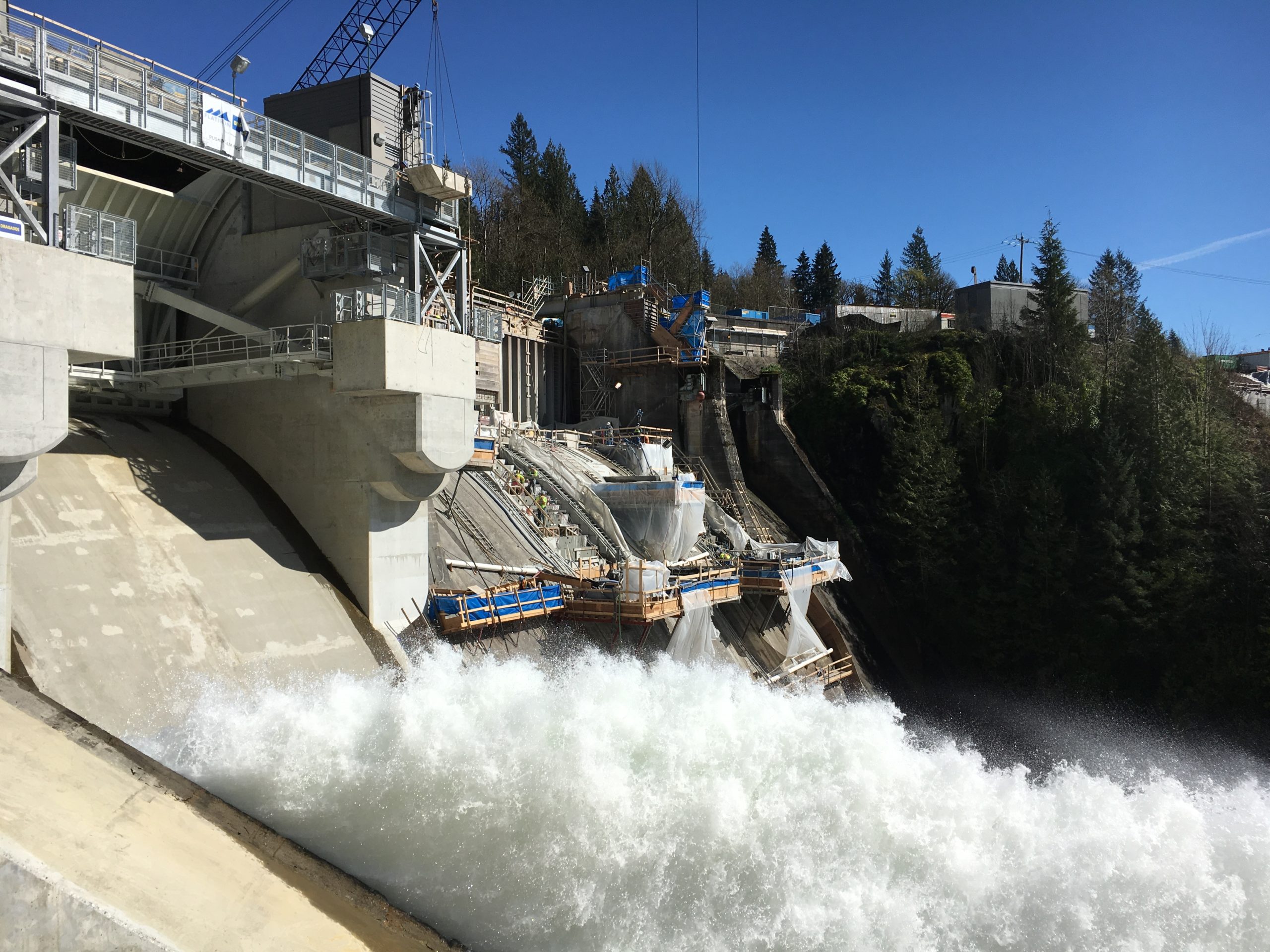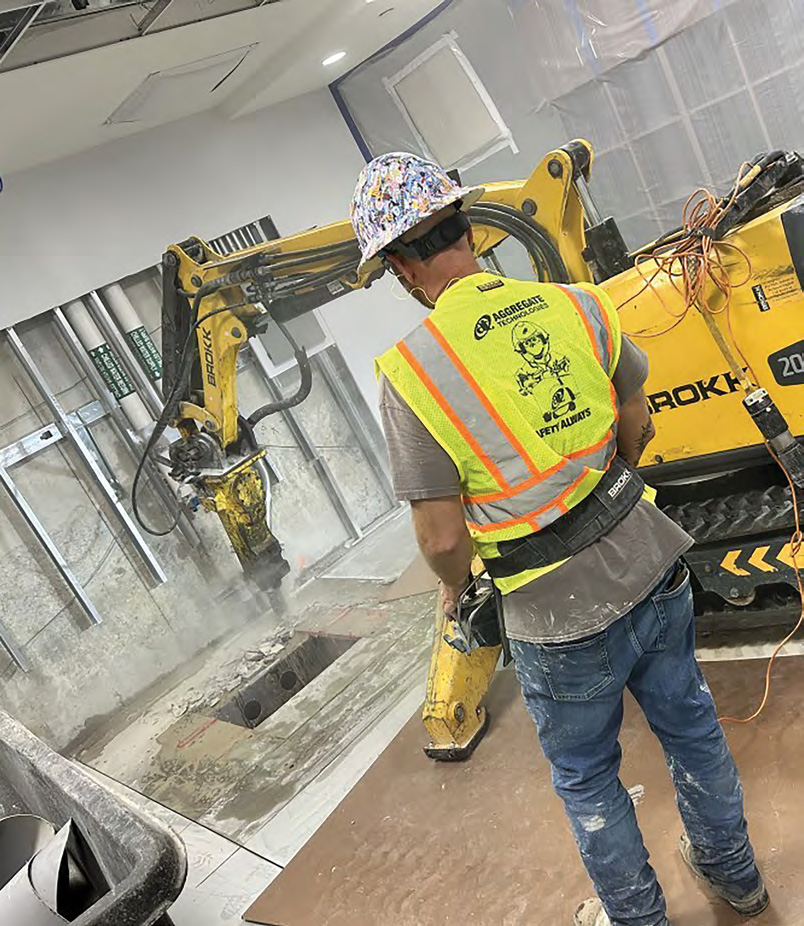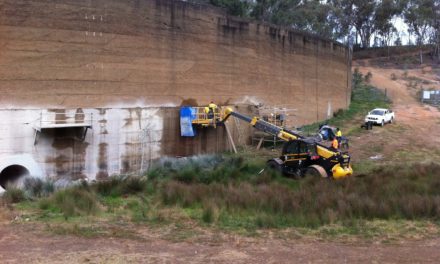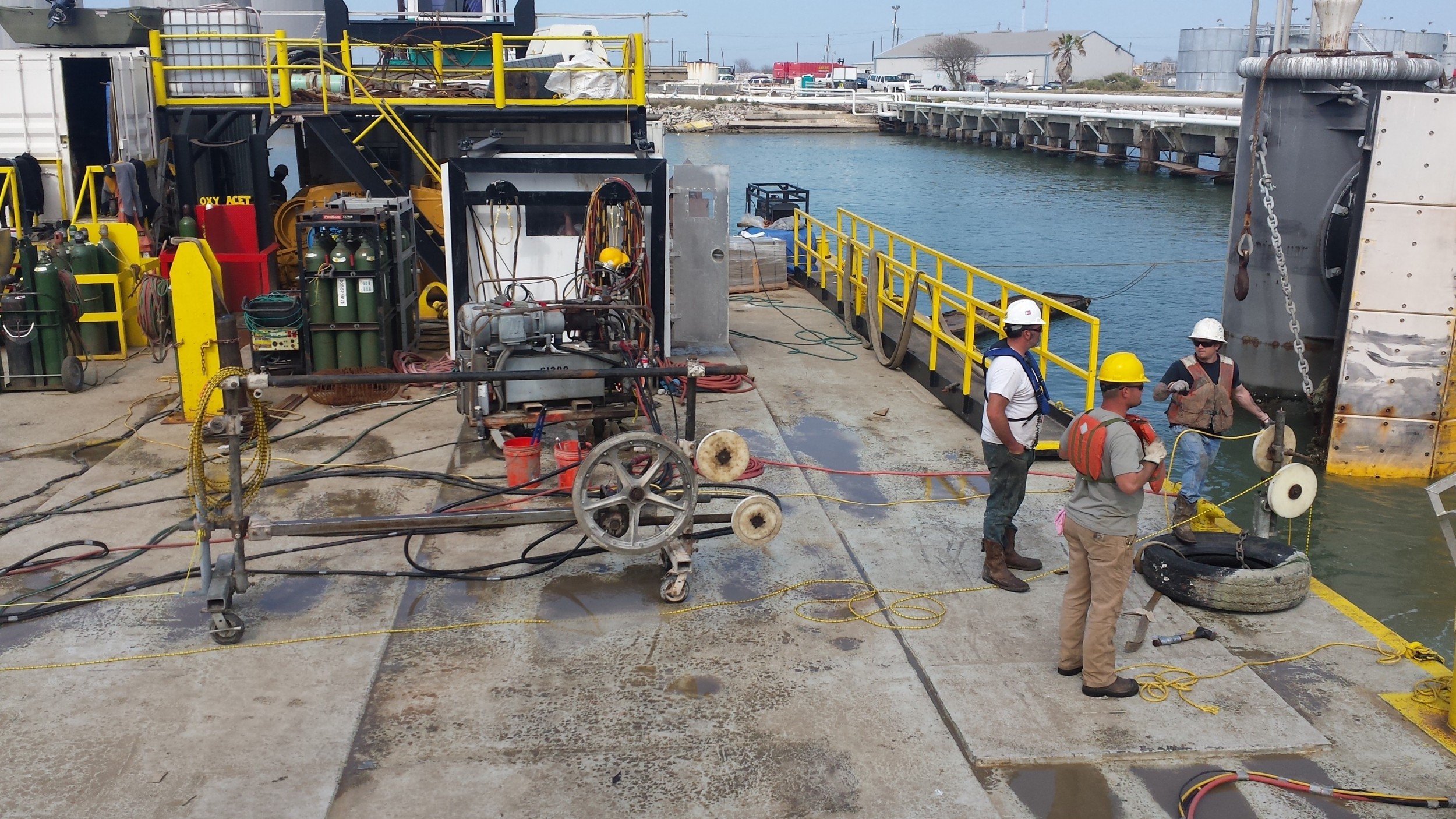
Saw Cutting Mission

Specialty Contractor Reinforces Dam for Seismic Events
This was a concrete sawing and drilling job of seismic proportions—20 million pounds cut and removed above and below water, 5,000 holes cored to depths up to 12 meters (39.4 feet), 697 square meters (approximately 7,500 square feet) of surface scarified—completed in phases over a three-year period.
An aging dam structure located in Mission, British Columbia, Canada was in need of upgrades and reinforcement to prevent a critical failure in the event of an earthquake. In addition, equipment in the dam’s powerhouse—built in the 1930s—was obsolete and could not provide the required amount of output, so it needed to be replaced.
Ruskin Dam is a 110-meter-long (360.9-foot) and 59-meter-tall (193.6-foot) concrete gravity type. The dam creates a reservoir (Hayward Lake) with a 42,000,000 cubic meter (34,050 acre-foot) capacity and its spillway is an ogee-type that consists of seven radial gates. The dam’s powerhouse is immediately adjacent on the river’s eastern bank and contains three 35-megawatt turbine-generators. Access to the powerhouse is by a truss bridge from offices on the west side of the river.
The $800-million CAD ($625-million USD) of upgrades and seismic reinforcement at Ruskin Dam would help it withstand an earthquake, increase its reliability and efficiency, create a two-lane road and pedestrian walkway over it and restore the heritage façade of the powerhouse building. The overall project began in 2012.

Updates were required at the 110-meter-long (361-foot) and 59-meter-tall (195-foot) Ruskin Dam.
The concrete sawing and drilling work involved the cutting and removal of four existing piers, the bridge deck and sections of the spillway. Other tasks included cutting free old generators, intakes, gate slots, draft tubes and creating new steps on the spillway for pier forms. In addition, deep hole drilling was specified for the installation of seismic anchoring and the spillway surface required scarifying for reinstatement. Coast Cutting & Coring Ltd., a division of CSDA member Westcoast Cutting & Coring Group Ltd. based in New Westminster, British Columbia, was initially awarded the work at Ruskin Dam in January 2015 and completed its final tasks almost three years later.
There were a number of factors complicating this job, both from an environmental aspect and in terms of specifications. A large portion of the work was done on the face of the dam spillway, which was on a 60-degree slope with limited access. In addition, it was specified by Flatiron/Dragados Joint Venture & Voith Hydro, the general contractors for the project, that there be a 1-inch tolerance for the form work. It was also made known to Coast Cutting & Coring Ltd. that the reservoir below the work area contained salmon that were spawning, so protection of this wildlife and water within the reservoir had to be considered when planning the work.
Cutting of the dam structure and powerhouse was done simultaneously, with a total of 30 operators working six days a week in alternating shifts during each phase of the work. Tasks on the dam section started with the slab sawing and removal of the existing concrete bridge deck that was 6 meters (19.7 feet) wide. Holes were cored through the deck so the steel shafts from the old gates could be cut free, then lengths of concrete railings were braced with knee braces and cut for removal. Deck pieces were slab sawed between the bridge beams with a Husqvarna 4800D, leaving three bridge beams in place. At this point, wire saws were positioned on both sides of the beams to cut them free. The beams were supported then removed one at a time by crane.

New steps were cut in the 60-degree sloped dam wall for the installation of new steel formwork.
The intakes at Ruskin Dam had slots cut into them on both sides measuring approximately 18 meters (59 feet) tall and 8 meters (26.2 feet) wide for gates to be installed. These gates allowed the flow of the intake water to be stopped for any maintenance needed on the generators. The lintel beam and sill beam were cut and then chipped out to save existing reinforcement for structural tie ins. Concrete was cut with Husqvarna hi-cycle hand saws, while the chipping was done with a Husqvarna DXR310 demolition robot.
Coast Cutting & Coring then cut four free-standing piers, three of which were 12 meters (39.7 feet) square and 2 meters (6.7 feet) thick, which were divided into 48 pieces each weighing approximately 35,000 pounds. One of the piers was poured against a rock face and was around one-third larger than the others. This pier was cut into 58 pieces. Scaffold and platforms were set up for access to one side of this pier and a narrow hanging platform positioned on opposite side to provide access for slurry containment and wire access. The scaffold was set up in 2.5-meter (8.2-foot) sections as the pieces were cut into roughly 1-meter (3.3-foot) by 2-meter (6.6-foot) sections. This way, two rows of blocks could be lifted prior to removing one section of scaffold.
Operators cored 5-centimeter-diameter (2-inch) holes through the piers for wire access, and the wire was pulled vertically in sizes ranging from 2.5 square meters (27 square feet) to 26 square meters (279.9 square feet). The larger cuts required 46 meters (151 feet) of wire supplied by Cyclone Diamond Products. The contractor employed two Hilti DSW 3018 wire saws and manipulated the wire to perform two cuts at the same time, either horizontally or vertically or opposite directions, to increase productivity and schedule. Cut pieces were lifted out by a 275-ton crane set up on a floating barge nearby. The crane placed the pieces onto an adjacent barge as the work area was too far from shore, and when the barge was full it transported the concrete to shore to be removed from site and recycled. Sections of scaffold were taken down after two rows were completely cut, and this process was repeated seven more times.
“We were cutting on multiple piers at the same with an average cutting speed of 3 square meters (32.3 square feet) an hour and each saw cut up to 28 square meters (301.4 square feet) each day,” said Dario Babic, partner for Coast Cutting & Coring Ltd.
The final pier removed was the larger structure that was poured against the rock face. Having no access to the backside of the pier, the contractor made a grid pattern of 12-meter-deep (39.4 foot) intersecting core holes with Weka SR68 drills to allow sections to be cut free with a wire saw. As each cut intersected with another, holes had to be cored from front face to intersect and the pier was cut into 58 pieces. This was 509 holes with operators coring more than 18 meters (59.1 feet) each per man per shift, totaling 1,551 meters (5,088 feet) of coring drilling.
The dam had seven existing gates but the project required this number to be reduced to five, so new steps were cut in the 60-degree sloped dam wall for the installation of new steel formwork. A combination of wall sawing and wire sawing was performed using a Husqvarna WS 482 wall saw, a Pentruder 8-20 wall saw and the company’s Hilti DSW3018 wire saw. Operators started at the top and bottom of the spillway simultaneously because the schedule only allowed 17 days to complete this task. Each step was around 4.5 meters (14.8 feet) wide starting at a 45-centimeter (17.7-inch) height and 60-centimeter (23.6-inch) depth step pattern, increasing in size to 127 centimeters (50 inches) high by 90 centimeters (35.4 inches) deep at the bottom.
From the top, the steps were cut vertically down by custom blades from Cyclone Diamond Products and were powered by the Pentruder wall saw. Corners were finished by CW630 chain saws from ICS, but also core drilled vertically and horizontally to create wire access holes to finish the end cuts. Working from the bottom required a different strategy because of the depth of the steps. Holes were cored vertically down past the required depth of the step so pulleys could be placed in the 18-centimeter-diameter (7.1-inch) holes, allowing operators to push the wire down rather than pulling it. As the work continued, two more crews began working from the top and bottom of the wall, coring pilot holes vertically and horizontally. This was so that a rock drilling contractor could create openings for dowel installations that would anchor the new piers to the bedrock.

The contractor scarified 697 square meters (approximately 7,500 square feet) of concrete surface.
Also during the project, Coast Cutting & Coring was asked to remove 15 centimeters (6 inches) off the surface of the spillway and create a rough surface. Water blasting was used for a portion of this task but was time consuming, so the contractor again used its diamond cutting tools. The area was a 12-meter (39.4-foot) square that was wall cut into 16 smaller square panels measuring 3 meters (9.8 feet). As wall sawing of the panels progressed, a wire saw crew placed diamond wire into the cuts and performed pull cuts to achieve the new surface profile. Each piece took about two to three hours to complete. After each row of four pieces were lifted out, a Husqvarna DXR310 demolition robot fitted with a milling head scarified the surface so that new concrete could be poured onto it. This task was particularly successful and the contractor finished a full three weeks ahead of schedule.
This was a huge job for Coast Cutting & Coring, or any contractor for that matter. To keep up with some additional tasks added to the project, the contractor invited fellow CSDA member Di-Tech International of Winnipeg, Manitoba to assist and partner on the spillway demolition work.
“Di-Tech International assisted us with tooling, crew members and general guidance from the owners. Working with Steve Johnston and Luke Dufalt ensured the job was a great success and created a bond between our two companies,” explained Babic.
In addition to the large amount of work completed on the dam spillway, the cutting contractor also had several tasks to complete at the nearby powerhouse. These tasks included the cutting of a 9-meter-diameter (29.5-foot) steel pipe, the dissection of a stator into six pieces, the removal of numerous concrete bases and the creation of 1.5-meter (5-foot) by 7.5-meter (24.6-foot) openings between the three levels of the powerhouse to aid in the cooling of the new dam generators.
On the reservoir side of the dam, underwater wall sawing techniques were employed to cut slots for the coffer dam. A Husqvarna WS 360 hydraulic wall saw fitted with a 61-centimeter-diameter (24-inch) blade made the required cuts. Each slot took seven days to complete with a crew working 12-hour shifts.
Over the three-year period of the Ruskin dam spillway and powerhouse job, Coast Cutting & Coring Ltd. helped the general contractor remove 20 million pounds of concrete. To complete the sawing and core drilling tasks safely on the 60-degree slope of the dam wall, specialized work platforms were erected and all workers were fitted with harnesses and fall arrest equipment.
To make sure the salmon living in the dam reservoir remained healthy and unharmed during the work, a three-tier slurry containment system was employed. On every scaffold platform a rubber membrane was installed and slurry was pumped into totes. From the totes, the slurry was pumped across to the other side of the dam where it was processed. Shrink wrap was used around the scaffold decks to prevent any overspray containing the slurry and two gutter systems were installed to capture any that escaped.
“Our work at Ruskin Dam was arguably the most challenging project we have ever done—it certainly had the most demanding schedule,” said Babic. “We believe this was the largest concrete sawing and core drilling project in Canada in terms of volume. We worked six days a week with alternating shifts on an open platform, sometimes in snow and icy conditions, and had to be extremely careful when it came to the control and containment of slurry.”
“The work was completed ahead of schedule and within budget, and additional phases were awarded based on the success of original contract,” continued Babic. “Most importantly, we left the jobsite with zero lost time incidents. This was possibly the most satisfying part about the whole job and our superintendent Ken Thornton, deserves a mention. His motivation and expertise were a driving factor behind this outcome.”
The upgrade and reinforcement work at Ruskin Dam was completed September 2017.
Company Profile
Established in 1976, Coast Cutting & Coring Ltd., a division of Westcoast Cutting & Coring Group Ltd., is based in New Westminster, British Columbia, Canada and has been a CSDA member for 16 years. The company has support locations in Vancouver Island and Prince George, has 60 employees, 50 trucks and offers the services of slab sawing, core drilling, wall sawing, wire sawing and selective demolition.
Resources
General Contractor:
Flatiron/Dragados Joint Venture, Voith Hydro
Sawing and Drilling Contractor:
Coast Cutting & Coring Ltd.
Vancouver, British Columbia, Canada
Phone: 604-291-1448
Email: dariob@coastcutting.ca
Website: www.coastcutting.ca
Methods Used: Slab Sawing, Core Drilling, Wall Sawing, Wire Sawing, Selective Demolition














